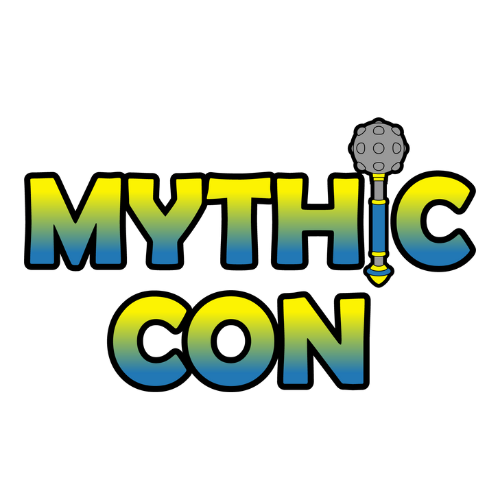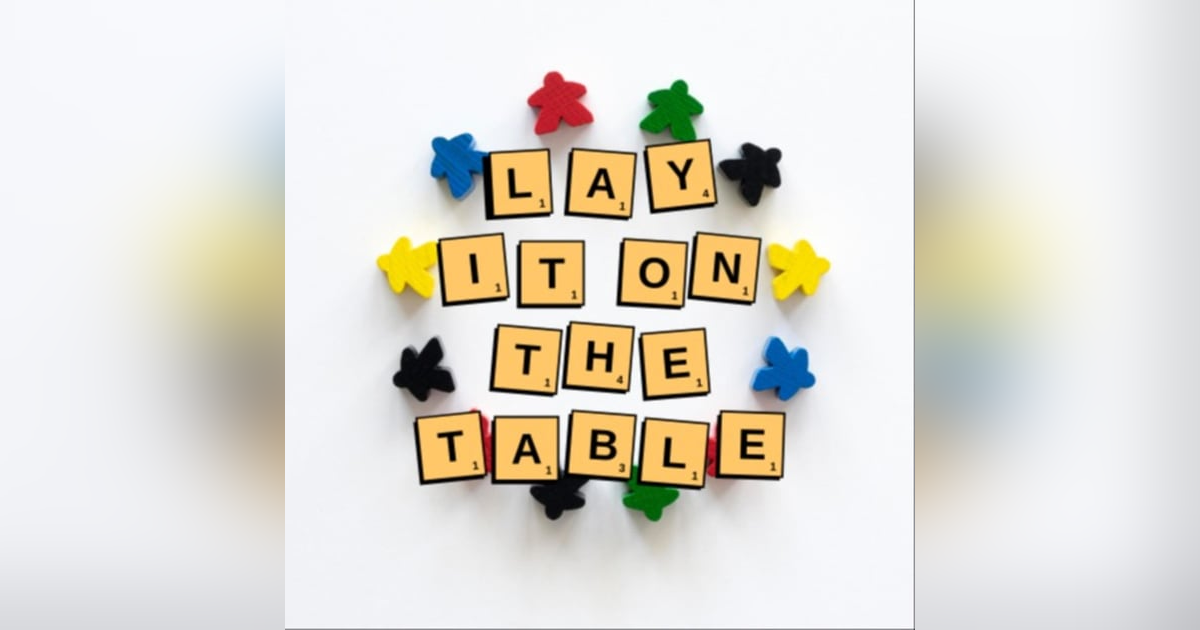Rust Never Sleeps
In this episode, hosts Joe Mahaffey and James Engelhardt discuss their return to the podcast after a hiatus, share updates on upcoming episodes, and highlight the Mythicon convention in Charlotte, North Carolina. They delve into industry news, including Gamma's global expansion, the strike by Kickstarter employees, and financial challenges faced by CMON and Elf Creek Games. The hosts also review two games: Trinket Trove, a quick and easy card game, and The Red Cathedral, a medium-weight game with a unique dice-based rondelle mechanic. Finally, they explore Everdell: Silver Frost, a sequel that introduces new mechanics and challenges. In this engaging conversation, Joe Mahaffey and James Engelhardt explore various board games, discussing their mechanics, organization, and personal experiences. They delve into new titles like 'Everdell' and 'Tribes of the Wind', share insights on the village-building game 'Hamlet', and express frustrations with game organization and inserts. The duo also reflects on classic games like 'Backgammon' and discusses the potential of new ventures in the board game and puzzle industry.
In this episode, hosts Joe Mahaffey and James Engelhardt discuss their return to the podcast after a hiatus, share updates on upcoming episodes, and highlight the Mythicon convention in Charlotte, North Carolina. They delve into industry news, including Gamma's global expansion, the strike by Kickstarter employees, and financial challenges faced by CMON and Elf Creek Games. The hosts also review two games: Trinket Trove, a quick and easy card game, and The Red Cathedral, a medium-weight game with a unique dice-based rondelle mechanic. Finally, they explore Everdell: Silver Frost, a sequel that introduces new mechanics and challenges. In this engaging conversation, Joe Mahaffey and James Engelhardt explore various board games, discussing their mechanics, organization, and personal experiences. They delve into new titles like 'Everdell' and 'Tribes of the Wind', share insights on the village-building game 'Hamlet', and express frustrations with game organization and inserts. The duo also reflects on classic games like 'Backgammon' and discusses the potential of new ventures in the board game and puzzle industry.
Season 4, Episode 10
Rust Never Sleeps
Bill and Ted Reunite.
https://youtu.be/iTy5rO9QraU?si=ou3AsGSvr_uRAGCk
News and Notes
Mythic Con
 https://tabletop.events/conventions/mythic-con-2025
https://tabletop.events/conventions/mythic-con-2025
News
Industry Observations: GAMA, Kickstarter, CMON, and Elf Creek
 https://www.spiel-essen.de/en/
https://www.spiel-essen.de/en/How to play what is on our tables
Joe
 https://boardgamegeek.com/boardgame/436931/trinket-trove
https://boardgamegeek.com/boardgame/436931/trinket-trove/pic8985794.jpg)
Beneath the floor boards and between the walls, a secret world thrives. By moonlight, the collectors scurry into quiet corners in search of tiny treasures: mirrored lockets, shiny buttons, gleaming gems, and more. When dawn breaks, the animals retreat to their snug little burrows to share stories and trade the night’s trinkets.
OVERVIEW
In a game of Trinket Trove, you are a collector – a cute little critter living in the margins of the human world. You trade and collect sets of trinkets to decorate your burrow. You begin with a hand of 4 trinket cards, and each round new trinket cards will be drawn face up into the center of the table. You and the other players will take turns bidding for draft order, by offering up trinket cards from your hand. Then players will take turns claiming the trinkets on the table, including the bids offered up by other players, and placing them in their hands. At the end of 5 or 6 rounds you score your hand of trinkets and the player with the most points wins!
 https://boardgamegeek.com/boardgame/436821/everdell-silverfrost
https://boardgamegeek.com/boardgame/436821/everdell-silverfrost/pic8646704.png)
Silverfrost is the next standalone edge of the map series of Everdell. Beyond the snow-capped Spirecrest mountains to the south of Everdell Valley, lies the bold country of Silverfrost. It is your task to build and maintain a city in this challenging landscape. You must clear the piling snow, burn the fires to keep your citizens warm and prosperous, and complete important quests for the Ranger’s Guild.
In Silverfrost, you send critter workers to various Locations on the board, cards, or the mountain to gather resources and activate unique effects. You use these resources to play cards face up in front of you, forming your own city. Each turn, you take 1 of 3 possible actions — Place a worker, Play a card, or Prepare for the next season.
You may place 1 of your workers on any Basic Location, Red Destination card in your city or opponent’s cities, the Forge, the Hot Springs, or a mountaintop Beacon, so long as it is not blocked by Snow or another worker. You then claim the listed resources or perform the action. If there is Snow at the location, you must first spend a Fire resource to clear the snow pile. If you use your unique Ranger worker, you can visit an occupied location, or gain a Fire resource if visiting a location alone.
To play a card, you must pay the listed cost of resources. If it is a Critter, you may instead play it for free by using 1 of your 2 Chimneys, so long as you have the necessary Fire to light it. Cards may be played either from your hand, or from the area of face-up cards on the board known as the Valley. Nearly all of the cards in Silverfrost feature new and powerful abilities, offering a huge variety of strategic depth and combos to explore.
If all of your workers are deployed, you may prepare for the next season by bringing back all of your workers, gaining a new worker, and performing the action described for the following season, introducing new snowfall to the board and to your city, as well as other challenges. A player is finished when they have played through the last season (Spring) and cannot perform any more actions. After all players have finished, the player with the most points is the winner.
 https://boardgamegeek.com/boardgame/276086/hamlet-the-village-building-game
https://boardgamegeek.com/boardgame/276086/hamlet-the-village-building-game/pic7315662.jpg)
When you think of a Village builder you sometimes think of card tableaux or static hex tile grids.
Think again!
Lots of buildings, all with different shapes, all fitting together in interesting ways.
One central Hamlet that the players contribute to, with its own self-forming demand and supply economy.
Villagers walking through the Hamlet, delivering food to households and building resources to construction sites.
And one day, the Church will finally be built, and the once-little Hamlet has become a fledgling town.
Who will be the biggest benefactor when that happens?
Including solo mode by Nick Shaw & Dávid Turczi
—description from the designer
Hamlet is a medium weight competitive village builder where players are communally turning their Hamlet into a bustling little town. In this tile placing game, players construct buildings that everyone can use to create materials, refine resources, earn money and make important deliveries to construct the Hamlet’s big landmark - the Church.
The game features irregular shaped tiles that connect together without a grid to form a village that is completely different every time. The tile placement organically creates interconnecting paths that the villagers use to transport resources across the village. This leads players to construct boards where no two games will ever feel the same. Since the buildings are communal, this also creates a fluid economy, where players are always working hard to provide the village with the resources that are most needed.
The game is designed by David Chircop (Petrichor, The Pursuit of Happiness). It plays between 1 to 4 players, with a solo mode currently being developed. It will be published by award winning studio Mighty Boards (Excavation Earth, Posthuman Saga).
JAMES
The Red Cathedral
https://boardgamegeek.com/boardgame/227224/the-red-cathedral
 https://boardgamegeek.com/boardgame/227224/the-red-cathedral
https://boardgamegeek.com/boardgame/227224/the-red-cathedral/pic5556025.jpg)
Autumn is not the best time to climb up on a scaffold in Moscow, but it is still far better than doing so in the winter. Tsar Ivan wants to see results and our team will prove to him that we are the best builders in the city. We are sure to finish off those decorative arches with the brightest shining stones and ensure our place on the list of the government’s trusted workers.
Sheila Santos and Israel Cendrero make up the game designing duo known as Llama Dice. To date they have put out various titles with different Spanish publishers (1987 Channel Tunnel, Mondrian, Smoothies), and The Red Cathedral is the first game they have published with Devir. Pedro Soto (Holmes, Sherlock & Mycroft, Papua) and Chema Román (El mundo de Águila Roja) took care of the graphic elements of the game with a grand homage to Ivan Bilibin, an iconic Russian artist from the turn of the twentieth century. Despite being from a far later period, his mark is very recognizable in the game.
The Red Cathedral is a strategic, “Euro” board game in which the players take the roles of construction teams. Their job is to work together to put up St. Basil's cathedral in Moscow, as ordered by Ivan the Terrible. However, only one of them will be able to gain the favor of the Tsar.
During the game, the players can carry out one of these three actions: assign a section of the cathedral, send resources to that section to build it, or go to the game board to achieve more resources. Each of these actions has its own mechanism and requires that the players pay close attention to what the other players are doing.
When the sections of the cathedral are assigned the players take possession of the spaces in each of the columns that make up their section. The more sections built and the completion of each with its own tower, the more points the player will be given at the end of the game.
The players can send resources to the cathedral sections that they have claimed. When they complete each of those sections they will obtain rewards in money and prestige points. They will also be able to install decorations on the completed sections to achieve even more recognition from the Tsar. This part of the game also works as a clock, since once any player completes the construction of their sixth section it brings about the end of the game.
The game board shows us the iconic rondel of The Red Cathedral. It is where the players obtain all the resource types needed to complete their work on the cathedral, as well as to get favors from the guilds and professionals to make the most of their trip to the market. In the central rondel the players choose the die they wish to use and move forward as many spaces as is shown on the top side of said die, in order to obtain the resources indicated in the space destined by the die.
The Red Cathedral is a very accessible game with regard to its rules because it is very easy to understand the various levels of the game, but it remains very interesting with regard to strategy. It is sure to please those who are more interested in the challenge offered by trying to strategically optimize their position in each game rather than the complexity of the rules.
 https://boardgamegeek.com/boardgame/362986/tribes-of-the-wind
https://boardgamegeek.com/boardgame/362986/tribes-of-the-wind/pic6871609.jpg)
In a post-apocalyptic world, the tribes of the wind are going to rebuild the world on the polluted ruins from the past.
Players will have to plant forests, build new villages and temples, and decontaminate surrounding areas.
They will be able to play cards from their hand. But be careful! The effect or even the possibility of playing the card may vary depending on... the back of your surrounding opponents' cards.
Players may also send their wind riders to explore the area, plant forests, or build villages and temples using all the gathered resources.
As the game progresses, you strive to complete objectives that will allow you to unlock your guide's special abilities, and to improve your tribe's powers.
When someone builds their 5th village, the end of the game is triggered. The player with the most points, depending on pollution, villages, temples, layout of their forests, and other various objectives, wins!
 https://boardgamegeek.com/boardgame/150999/valley-of-the-kings
https://boardgamegeek.com/boardgame/150999/valley-of-the-kings/pic1848490.jpg)
When you die, you can take it with you!
Take on the role of Egyptian nobles at the time of the pharaohs, preparing for death and burial in the Valley of the Kings. Players want to fill their tombs with food, canopic jars, statues, amulets and other treasures, and to do so they acquire cards that are laid out in the shape of a pyramid; purchase cards at the base of the pyramid, and it "crumbles" to bring cards higher in the pyramid to the base where they can be bought. The pyramid resets each round with new offerings.
You score only for cards that you remove from your deck and stash in your tomb, so if you keep using valuable cards for their effects and don't entomb them before the game ends, you could lose out on big points! Whoever collects the most valuable artifacts in her tomb wins.
 https://boardgamegeek.com/boardgame/178336/worlds-fair-1893
https://boardgamegeek.com/boardgame/178336/worlds-fair-1893/pic2721792.png)
The World's Fair of 1893 in Chicago was a spectacular international exhibition that showcased many great achievements in science, technology, culture, and entertainment. Acting as organizers of the fair, players work diligently to increase their influence throughout the fair and obtain the grand exhibits that will be put on display. The organizer who has earned the best reputation when the fair begins will emerge the victor.
On each turn of World's Fair 1893, the active player sends a supporter to one of the five areas and gathers all of the cards in it. New cards are then added to some of the areas, and the next player takes a turn.
The five areas represent sections of exhibits, like Fine Arts and Electricity. Cards may represent exhibit proposals in one of those five areas, influential people who provide bonus supporters, or tickets for attractions and concessions along the Midway.
The game consists of three scoring rounds, each triggered when players collectively gather a certain number of Midway tickets. Players gain reputation points for leading in number of supporters in an area and for gathering the most tickets in each round. The leaders in an area also receive approval for exhibit proposals they have gathered that match the area. Players gain reputation points at the end of the game based on the breadth and diversity of their approved exhibits.
 https://boardgamegeek.com/boardgame/2397/backgammon
https://boardgamegeek.com/boardgame/2397/backgammon/pic342451.jpg)
Backgammon is a classic abstract strategy game dating back thousands of years. Each player has a set of 15 checkers (or stones) that must be moved from their starting positions, around, and then off the board. Dice are thrown each turn, and each player must decide which of their checkers to move based on the outcome of the roll. Players can capture each other's checkers, forcing the captured checkers to restart their journey around the board. The winner is the first player to get all 15 checkers off the board. A more recent addition to the game is the "doubling cube", which allows players to up the stakes of the game. Although the game relies on dice to determine movement, there is a large degree of strategy in deciding how to make the most effective moves given each dice roll and measuring the risk in terms of possible rolls the opponent may get.
Backgammon may be the first game to be mentioned in written history, going back 5,000 years to the Sumerians of ancient Mesopotamia. During the 1920s, archaeologists unearthed five boards from a cemetery in the ancient town of Ur. At another location, pieces and dice were also found along with the board. Boards from ancient Egypt have also been recovered from the tomb of Tutankhamun, including a mechanical dice box, no doubt intended to stop cheaters.
The names of the game were many. In Persia, Takhteh Nard which means "Battle on Wood". In Egypt, Tau, which may be the ancestor of Senat. In Rome, Ludus Duodecim Scriptorum ("game of twelve marks"), later, Tabula ("table"), and by the sixth century, Alea ("dice"). In ancient China, T-shu-p-u and later in Japan, Sugoroko. The English name may derive from "Bac gamen" meaning "Back Game", referring to re-entry of taken stones back to the board. It was often enjoyed by the upper classes and is sometimes called "The Aristocratic Game". The Roman Emperor Claudius was known to be such a fan of Tabula that he had a set built into his coach so he could play as he traveled (the world's first travel edition?).
The rules in English were standardized in 1743 by Edmond Hoyle. These remained popular until the American innovations of the 1930s.
New to the Collection
Joe
 https://boardgamegeek.com/boardgame/437705/horrified-dungeons-and-dragons
https://boardgamegeek.com/boardgame/437705/horrified-dungeons-and-dragons/pic8718235.jpg)
Terror is in the eye of the beholder! Horrified: Dungeons & Dragons will not only set players against four of the classic role-playing game's most fearsome foes, but will also introduce new gameplay elements inspired by the mechanisms of D&D, including the use of a 20-sided die.
Horrified: Dungeons & Dragons features gameplay elements familiar to players of other games in the series: Players work together to face monsters and puzzle-like obstacles to gather item tokens, protect citizens, and avoid attacks. Unique and thematic challenges for each monster further immerse players into the detailed setting and story. Additionally, each player chooses to play as one of five heroes inspired by character classes from D&D: wizard, rogue, fighter, cleric, or bard — each with a unique set of abilities that can aid their party as they move around the board to defeat the monsters dwelling in the dungeon below Waterdeep.
 https://boardgamegeek.com/boardgame/453406/wyrmspan-dragon-academy
https://boardgamegeek.com/boardgame/453406/wyrmspan-dragon-academy/pic9079437.jpg)
As a budding dracologist, you open an academy for fledgling dragons to achieve their full potential! The expansion to Wyrmspan adds a wide variety of new dragons and caves, objective tiles, dragon guilds, and a new round tracker that presents you with an income choice when you pass for the round. Welcome to Wyrmspan: Dragon Academy, designed by Connie Vogelmann and illustrated by Clémentine Campardou!
James
Kickstarter
Joe

Obsession
Fun
 https://www.amazon.com/stores/Newverest/page/C3ABC57D-6E6D-4495-91E4-5E777855E8AD?is_byline_deeplink=true&deeplink=66098D83-71BA-4BEE-A22F-1E0688732F2D&redirect_store_id=C3ABC57D-6E6D-4495-91E4-5E777855E8AD&lp_asin=B08TMT2CY8&ref_=ast_bln&store_ref=bl_ast_dp_brandLogo_sto
https://www.amazon.com/stores/Newverest/page/C3ABC57D-6E6D-4495-91E4-5E777855E8AD?is_byline_deeplink=true&deeplink=66098D83-71BA-4BEE-A22F-1E0688732F2D&redirect_store_id=C3ABC57D-6E6D-4495-91E4-5E777855E8AD&lp_asin=B08TMT2CY8&ref_=ast_bln&store_ref=bl_ast_dp_brandLogo_sto


















